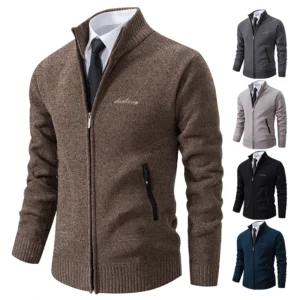Introduction: Beyond Winter – Cashmere’s Unexpected Versatility
Cashmere isn’t just for winter anymore. This luxurious fabric has long been pigeonholed as exclusively cold-weather wear, but this limiting perception overlooks its remarkable adaptability to fluctuating temperatures. The natural properties of cashmere make it an ideal companion for unpredictable weather, offering both warmth when needed and breathability when temperatures rise.
Investing in quality cashmere pieces means adding versatile items to your wardrobe that work across seasons and diverse weather conditions. Unlike synthetic materials that excel in only specific temperature ranges, premium cashmere adjusts to your body’s needs, providing comfort whether you’re facing a crisp morning that warms to a mild afternoon or navigating the temperature swings of early spring.
The cashmere in transitional weather performs remarkably well because of its natural fiber structure. For centuries, people across various climates have relied on cashmere for its adaptability – from the harsh mountain winters of Mongolia to the moderate seasonal changes of European climates.
In this comprehensive guide, we’ll explore the science behind cashmere’s temperature-regulating properties, strategies for choosing the right pieces, layering techniques for maximum versatility, and practical styling tips for diverse weather scenarios. You’ll discover how to transform your cashmere collection into a year-round wardrobe solution that keeps you comfortable no matter what the forecast brings.
The Science of Comfort: Why Cashmere Adapts to Temperature Swings
The remarkable adaptability of cashmere to fluctuating temperatures isn’t just luxury marketing – it’s grounded in the unique structure of the fiber itself. Cashmere comes from the undercoat of the cashmere goat, which naturally evolved to protect these animals through extreme temperature variations in their native habitats.
What makes cashmere particularly exceptional for unpredictable weather is its fiber structure. At just 14-16 microns in diameter (compared to human hair at 70-100 microns), cashmere fibers are incredibly fine. This exceptional thinness contributes to several key properties that make cashmere ideal for changing weather conditions:
Natural thermoregulation: Cashmere fibers have a hollow core structure that traps up to three times more air than regular wool. This air pocket serves as natural insulation, keeping you warm when it’s cold while allowing excess heat to escape when temperatures rise.
Superior breathability: The fibers allow air circulation, preventing overheating and the clammy feeling often associated with synthetic materials.
Moisture-wicking capabilities: Cashmere can absorb up to 30% of its weight in moisture without feeling wet, pulling perspiration away from your skin to keep you comfortable.
Lightweight warmth-to-weight ratio: Premium cashmere provides exceptional warmth without bulk, making it ideal for layering without the heaviness of traditional winter fabrics.
Natural elasticity and softness: The fiber’s natural crimp allows it to stretch and return to shape, maintaining comfort throughout daily temperature fluctuations.
Understanding cashmere gauge numbers helps explain why certain pieces adapt better to changing conditions. The gauge refers to the number of stitches per inch, with higher numbers indicating a finer, lighter knit. High-quality Grade A cashmere can effectively adjust to body temperature changes of 15-20°F (8-11°C), making it remarkably responsive to both your body’s microclimate and external weather shifts.
This scientific foundation explains why cashmere outperforms many other natural and synthetic fabrics in variable conditions, providing the perfect balance between insulation and breathability that unpredictable weather demands.
Choosing the Right Cashmere for Unpredictable Weather
Selecting the ideal cashmere for fluctuating temperatures requires understanding a few key technical aspects. The versatility of your cashmere pieces largely depends on their construction, with ply, gauge, and weight being the primary factors determining performance across weather conditions.
Lightweight cashmere options offer exceptional adaptability for unpredictable weather. When evaluating cashmere for versatility, consider these characteristics:
Ply refers to the number of yarn strands twisted together. Single-ply cashmere is lighter and more suitable for warmer conditions, while two-ply offers greater durability and moderate warmth for transitional weather.
Gauge indicates knitting density – higher numbers (like 12-14) create finer, more versatile fabrics ideal for layering and temperature changes.
Weight is measured in ounces per yard, with 7-9 oz (200-250g) typically offering the best year-round performance.
| Type | Weight | Best For | Versatility |
|---|---|---|---|
| Single-ply | Lightest | Warmer days, layering | High |
| Two-ply | Medium | Transitional seasons | Very high |
| Three/Four-ply | Heaviest | Colder conditions | Moderate |
| Cashmere-silk blend | Very light | Spring/Summer | High |
| Cashmere-wool blend | Medium-heavy | Fall/Winter | Moderate |
Fabric composition also plays a crucial role in adaptability. Pure 100% cashmere offers exceptional thermoregulation, while cashmere wool cardigans provide additional structure and warmth for cooler days. For the warmer ends of transitional seasons, cashmere-silk blends deliver lightweight comfort with a cooling effect.
For a truly versatile wardrobe, focus on building a collection centered around two-ply, 12-14 gauge cashmere pieces. These specifications hit the sweet spot of warmth without overheating, breathability without being too cool, and appropriate weight for layering without bulk.
The right cashmere construction creates the foundation for successfully navigating unpredictable weather, setting you up for comfortable versatility throughout changing seasons.
Essential Cashmere Pieces for Your Versatile Wardrobe
Building a wardrobe that can handle weather fluctuations starts with selecting the right cashmere pieces. These foundational garments will serve as your go-to items when temperatures are unpredictable:
Lightweight Cardigans offer perhaps the greatest versatility in unpredictable weather. Open-front styles allow for easy temperature regulation – simply leave unbuttoned during warmer moments and close when the chill returns. Button-up cardigans provide more coverage for cooler conditions while remaining breathable. A mid-weight cardigan in a neutral shade becomes an essential layering piece that works across seasons.
Fine-Gauge Crewneck and V-Neck Sweaters provide versatile options that can be worn alone or layered. The crew neck offers more warmth around your neck on cooler days, while V-necks provide additional ventilation when temperatures rise. Look for 14-gauge sweaters that maintain structure while remaining lightweight.
Cashmere Wraps, Shawls, and Pashminas function as multi-purpose pieces that can be worn in numerous ways depending on the temperature. Drape loosely over shoulders during mild weather, wrap more securely when cooler, or remove entirely when warm. These adaptable accessories pack easily in a bag for on-the-go weather changes.

Cashmere Scarves serve as both functional weather protection and stylish accessories. A medium-weight cashmere scarf can be wrapped multiple ways, tucked inside a jacket on cool mornings, or carried for evening temperature drops.
Cashmere T-Shirts and Camisoles work beautifully as base layers that remain comfortable against your skin throughout the day. These thinner pieces regulate body temperature while serving as building blocks for layered outfits.
Cashmere Sweater Vests provide core warmth without restricting arm movement or causing overheating. These are particularly effective for days that start cool but warm significantly.
When selecting your versatile cashmere collection, prioritize cashmere sweaters in timeless designs that coordinate easily with multiple outfits. Neutral colors like camel, gray, navy, and black offer maximum versatility, while one or two pieces in signature colors can add personality to your transitional wardrobe.
The beauty of these essential pieces is their ability to work together or separately depending on the day’s weather demands. Each item performs optimally in a specific temperature range (approximately 45-70°F or 7-21°C), but when combined through strategic layering, they can accommodate much wider fluctuations.
Mastering Layering Techniques with Cashmere
The secret to wearing cashmere comfortably in unpredictable weather lies in strategic layering. Unlike bulky winter layering, cashmere’s thin yet insulating profile allows for sophisticated combinations that adapt to temperature changes throughout the day.
How to layer cashmere for spring and fall begins with understanding the three-layer approach:
Foundation Layer – Start with lightweight cashmere pieces directly against your skin. Cashmere tees, thin pullovers, or camisoles create a breathable base that regulates your body temperature. These pieces should be fine-gauge (16 gauge or higher) to prevent overheating and allow easy movement.
Mid-Layer – This adaptable middle layer provides your primary temperature control. Cashmere cardigans work perfectly here, as they can be buttoned or unbuttoned as needed. For cooler conditions, a lightweight cashmere sweater serves as an excellent mid-layer that can be easily removed when temperatures rise.
Outer Layer – For significant temperature fluctuations, consider a heavier cashmere wrap or oversized scarf that can function as a light outer layer. These can be draped over shoulders when needed or folded into a bag when not in use.
For accessory layering, consider these techniques:
Neck Transitions – A cashmere scarf loosely draped provides minimal warmth but can be wrapped more securely as temperatures drop.
Hand Coverage – Fingerless cashmere gloves allow dexterity while keeping wrists and palms warm during cool mornings.
Core Temperature Management – A cashmere vest over a lightweight sweater targets core warmth without restricting mobility or causing overheating.
Day-to-night transitions benefit particularly from cashmere layering. Start the day with multiple thin layers that can be adjusted as temperatures change. For example, a cashmere tee under a light sweater and cardigan provides three adjustment points throughout the day.
Indoor climate navigation requires special consideration. Office environments with unpredictable heating and cooling systems benefit from a layering approach centered around a cashmere cardigan that can be easily removed or added as the indoor climate changes.
With proper layering techniques, a single cashmere-centered outfit can comfortably accommodate temperature swings of 20-30°F (11-17°C) throughout the day, eliminating the need for complete wardrobe changes as conditions shift.
Styling Cashmere for Diverse Weather Scenarios

Creating stylish outfits that accommodate weather fluctuations requires thoughtful fabric pairings and strategic combinations. Cashmere’s natural elegance works beautifully with other materials to enhance both its adaptability and visual appeal.
For optimal breathability, pair cashmere with natural fibers:
Cashmere + Cotton – Lightweight cotton shirts under cashmere sweaters allow air circulation while adding minimal bulk. This combination excels when temperatures might increase throughout the day.
Cashmere + Linen – For spring and summer unpredictability, linen pants or skirts with lightweight cashmere tops balance breathability and warmth.
Cashmere + Silk – Silk scarves or blouses layered with cashmere create a luxurious temperature-regulating combination that works especially well in transitional months.
For textural contrast and enhanced versatility:
Cashmere + Denim – A classic pairing that works year-round. A lightweight cashmere sweater with jeans creates a versatile outfit that handles 45-70°F (7-21°C) temperature ranges comfortably.
Cashmere + Leather – Leather accessories or a light leather jacket over a cashmere sweater provides wind protection while maintaining breathability.
Specific outfit ideas for common scenarios include:
Spring Showers & Cool Mornings (40-60°F / 4-16°C)
* Layer a thin cashmere layer for transitional weather under a water-resistant jacket
* Pair a cashmere turtleneck with cropped trousers and ankle boots
* Style a cashmere cardigan over a t-shirt with jeans and lightweight sneakers
Warm Afternoons & Cool Evenings (60-75°F / 16-24°C)
* Start with a cashmere tank under a button-up shirt with rolled sleeves
* Carry a cashmere wrap for when temperatures drop after sunset
* Wear a lightweight cashmere sweater with shorts or a skirt for warm-day/cool-night transitions
Autumn’s Fluctuations (45-65°F / 7-18°C)
* Layer a thin cashmere sweater under a vest with jeans and boots
* Style a cashmere cardigan over a long-sleeve t-shirt with corduroy pants
* Pair a heavier cashmere pullover with a scarf that can be removed as needed
Accessorizing for temperature changes becomes second nature with cashmere. Keep a lightweight cashmere scarf in your bag for unexpected chills, or use a cashmere headband to protect ears during sudden wind while being easy to remove and store.
The key to maintaining a cohesive look while preparing for weather changes is selecting a consistent color palette across your layered pieces. This ensures that as layers are added or removed, your outfit remains visually harmonious despite the practical adjustments.
Care and Maintenance for Frequently Worn Cashmere
Cashmere worn in fluctuating conditions requires special attention to maintain its adaptive properties and extend its lifespan. Proper care ensures your versatile pieces continue performing optimally across changing seasons.
For cashmere that transitions between different environments and weather conditions, follow these specialized care practices:
Gentle Washing Practices
* Hand wash frequently worn cashmere every 5-7 wears using lukewarm water and mild cashmere shampoo or baby shampoo
* Submerge the garment fully and gently squeeze – never wring or twist
* Rinse thoroughly with clean water at the same temperature
* Press water out gently between clean towels
Proper Drying Techniques
* Lay flat to dry on a clean towel away from direct heat or sunlight
* Reshape while damp, gently stretching back to original dimensions
* Never hang cashmere to dry as it will stretch out of shape
* Allow complete drying before storing or wearing again
Smart Storage Solutions
* For cashmere in regular rotation, fold neatly and store in a breathable drawer
* Use acid-free tissue paper between folds to prevent creasing
* Allow 24 hours between wearings to let fibers rest and recover
* Keep from direct sunlight which can fade colors and degrade fibers
Pill Management
* Address pilling promptly using a cashmere comb or pill remover
* Gently remove pills by moving in one direction across the surface
* Focus especially on high-friction areas like underarms and sides
* Preventative combing once monthly extends garment appearance
The best way to clean cashmere sweaters depends on how they’re worn. For pieces that transition between indoor and outdoor environments frequently, refresh between washes by:
- Airing garments out overnight between wearings
- Using a fabric freshening spray formulated for delicate knits
- Spot-cleaning minor marks with a damp cloth and mild soap
- Steam-refreshing (holding steam at a distance) to release odors and relax fibers
During seasonal transitions, when cashmere pieces work hardest, inspect them more frequently for signs of wear and address issues immediately. This proactive care approach significantly extends the versatility and lifespan of your cashmere investment.
The Ultimate Travel Companion: Cashmere On-The-Go
When facing multiple climates and unpredictable weather during travel, cashmere proves itself as the ideal packing solution. Its natural properties make it uniquely suited for travelers who need adaptable, low-maintenance garments that perform across diverse environments.
The advantages of cashmere for travel include:
- Exceptional space efficiency – Cashmere provides warmth without bulk, allowing you to pack fewer layers
- Natural wrinkle resistance – Even after being packed for hours, cashmere recovers quickly with minimal creasing
- Odor resistance – Cashmere’s antimicrobial properties keep it fresher longer, requiring fewer washes while traveling
- Quick recovery – After a day of wear, cashmere bounces back with minimal care, ready for the next day’s activities
For maximum versatility while traveling, consider these packing strategies:
- Roll thin cashmere pieces instead of folding to save space and reduce creases
- Pack multi-functional pieces like women’s cashmere cardigans that can be styled multiple ways
- Bring one statement cashmere accessory (like a colorful wrap) that can transform basic outfits
- Select neutral-colored base pieces that mix and match easily
A thoughtfully selected cashmere travel wardrobe can create up to 10 distinct outfits from just 4-5 pieces. For example, a cashmere sweater, cardigan, tee, scarf, and tank can be mixed with basic pants and skirts to create outfits appropriate for temperatures ranging from 45-75°F (7-24°C).
For travelers moving between dramatically different climates, cashmere’s layering potential shines. A lightweight cashmere wrap weighing less than 8 ounces can provide the equivalent warmth of a bulky fleece layer weighing three times as much.
To refresh cashmere while traveling:
* Hang pieces in a steamy bathroom to release wrinkles and odors
* Spot clean as needed with a damp washcloth and hotel shampoo
* Allow pieces to rest flat overnight between wearings
* Layer with washable base layers to extend wear between cleanings
With these strategies, cashmere becomes not just a luxury but a practical travel essential that adapts to whatever conditions you encounter on your journey.
Return on Investment: Why Quality Cashmere is Worth It

Investing in high-quality cashmere that performs well across changing weather conditions delivers remarkable long-term value. While premium cashmere requires a higher initial investment, its adaptability significantly reduces the need for multiple seasonal garments.
Consider this simple cost analysis: A high-quality cashmere cardigan might cost $300-400, but it can replace separate spring, fall, and air-conditioned summer cover-ups that would collectively cost $500+ and lack cashmere’s temperature-regulating properties. When properly cared for, this versatile cashmere piece can last 5-10+ years, bringing the cost-per-wear down to mere cents while providing superior comfort.
Cashmere wrap sweaters offer particularly strong value propositions. Their adjustable styling options work across temperature ranges that would typically require 3-4 different garments made from lesser materials. This versatility translates directly to closet space efficiency and simplified decision-making.
The environmental benefits also deserve consideration. A capsule wardrobe built around adaptable, long-lasting cashmere pieces can reduce your clothing consumption by 30-40% compared to seasonal fast-fashion purchases. A single quality cashmere sweater often replaces multiple lower-quality items that would end up in landfills after just one or two seasons.
To identify quality cashmere that will maintain its versatility:
- Look for dense, even knitting without gaps or irregularities
- Check for resilience by gently stretching the fabric – it should return to shape quickly
- Examine fiber length through a simple pinch test – longer fibers will feel smoother and pill less
- Consider weight appropriate for your needs (7-9 oz for maximum versatility)
Quality cashmere’s adaptability to unpredictable weather makes it not just a luxury purchase but a practical investment in everyday comfort and simplified dressing.
Cashmere Wrap Sweaters, Women's Cashmere Pullovers
$75.89 Select options This product has multiple variants. The options may be chosen on the product pageCashmere Cable Knit Sweaters, Women's Cashmere Pullovers
Price range: $111.82 through $112.93 Select options This product has multiple variants. The options may be chosen on the product pageCropped Cashmere Sweaters, Women's Cashmere Pullovers
$155.77 Select options This product has multiple variants. The options may be chosen on the product page- Price range: $102.02 through $109.37 Select options This product has multiple variants. The options may be chosen on the product page
Oversized Cashmere Sweaters, Plus Size Cashmere Sweaters, Women's V-Neck Cashmere Sweaters
$136.87 Select options This product has multiple variants. The options may be chosen on the product pageStriped Cashmere Sweaters, Women's Cashmere Pullovers
$139.68 Select options This product has multiple variants. The options may be chosen on the product page
Why Choose Estate Cloth Cashmere for Unpredictable Weather?
When selecting cashmere specifically for temperature fluctuations, Estate Cloth offers distinctive advantages. Our premium Grade A cashmere, featuring fibers under 16 microns in thickness and exceeding 36mm in length, provides superior temperature regulation compared to lower-grade alternatives.
The manufacturing qualities that enhance Estate Cloth cashmere’s adaptability include a carefully calibrated tension during knitting that creates the ideal balance between structure and flexibility. This precise construction allows the garments to retain warmth without overheating – the exact performance needed when weather conditions vary throughout the day.
Our focus on timeless designs rather than seasonal trends ensures that each piece works seamlessly across multiple seasons and years. These versatile styles adapt to temperature shifts through thoughtful details like adjustable necklines, layering-friendly silhouettes, and weights calibrated for year-round comfort.
The comprehensive 12-point quality control process includes specific tests for the properties that enhance adaptability:
- Resilience testing ensures garments recover quickly when layered and unlayered
- Breathability assessments verify appropriate air circulation for temperature regulation
- Pilling resistance testing confirms longevity even with frequent wear in changing conditions
These quality measures support our commitment to creating garments that truly perform across seasons, providing practical luxury for everyday life regardless of what the weather brings.







